Dacia Spring vs Mazda CX-30 – Technische Daten, Verbrauch & Preise im Vergleich
Welches Modell überzeugt mehr – der Dacia Spring oder der Mazda CX-30?
Wir vergleichen für dich Leistung (65 PS vs 186 PS), Kofferraumvolumen (308 L vs 430 L), Verbrauch (13.20 kWh vs 5.70 L) und natürlich den Preis (15800 Fr. vs 28400 Fr.).
Finde jetzt heraus, welches Auto besser zu dir passt!
Der Dacia Spring (SUV) wird mit einem Elektro-Motor angetrieben und ist mit einem Automatik Getriebe ausgestattet. Im Vergleich dazu hat der Mazda CX-30 (SUV) einen Benzin MHEV-Motor und ein Manuel oder Automatik Getriebe.
In Sachen Kofferraumvolumen bietet dir der 308 L beim Dacia Spring bzw. 430 L beim Mazda CX-30 ausreichend Platz – je nachdem, worauf du Wert legst. Wer mehr Leistung sucht, muss wählen ob die 65 PS des Dacia Spring oder die 186 PS des Mazda CX-30 für die eigenen Bedürfnisse genügen.
Auch beim Verbrauch unterscheiden sich die beiden Modelle: 13.20 kWh vs 5.70 L. Preislich liegt der Dacia Spring bei 15800 Fr., während der Mazda CX-30 bei 28400 Fr. zu haben ist.
Vergleiche alle Daten direkt und finde heraus, welches Modell zu deinem Lifestyle passt!
Dacia Spring
The Dacia Spring stands out as an affordable and environmentally friendly option in the electric vehicle market, combining practicality with a compact design ideal for urban settings. Its minimalist interior, while basic, provides all the essential features needed for a comfortable drive, reflecting its cost-effective approach. The vehicle's performance suits city driving, making it an appealing choice for those seeking an entry-level electric car.
Details @ dacia-presse.de
@ dacia-presse.de
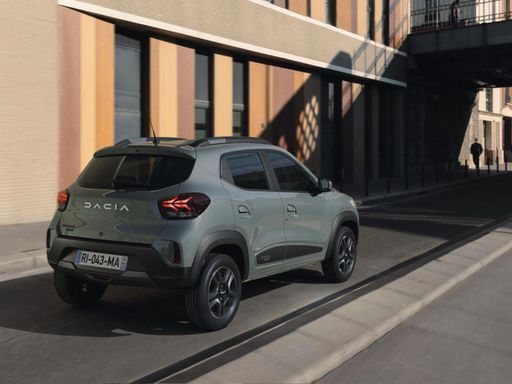 @ dacia-presse.de
@ dacia-presse.de
 @ dacia-presse.de
@ dacia-presse.de
Mazda CX-30
The Mazda CX-30 effortlessly combines sleek design with a sense of adventure, making it an appealing choice for urban explorers and countryside enthusiasts alike. Inside, the cabin is thoughtfully designed, offering both comfort and cutting-edge technology to enhance the driving experience. Its performance on the road is agile, providing a smooth and engaging journey for drivers and passengers.
Details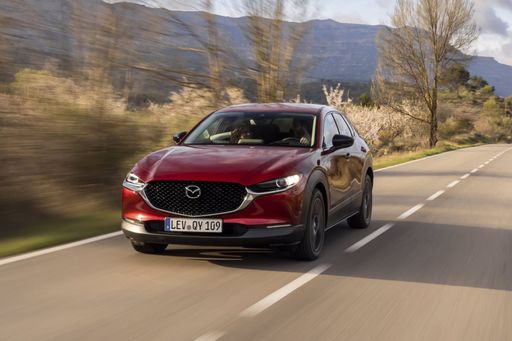 @ de.mazda-press.com
@ de.mazda-press.com
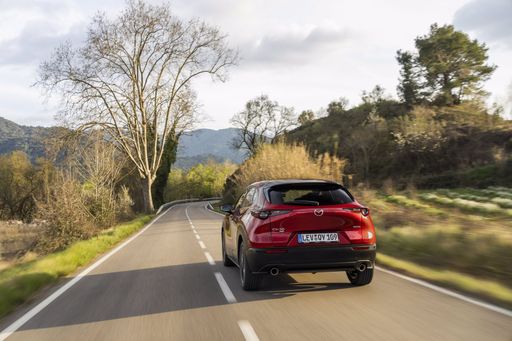 @ de.mazda-press.com
@ de.mazda-press.com
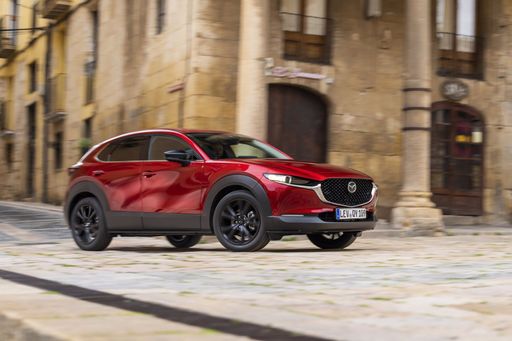 @ de.mazda-press.com
@ de.mazda-press.com
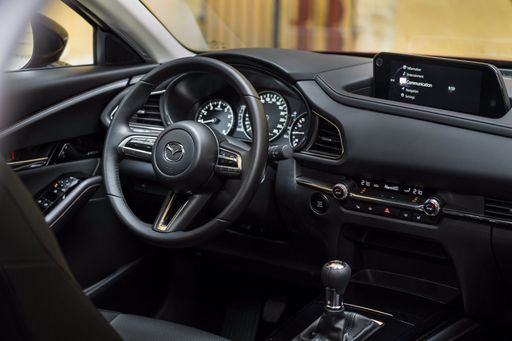 @ de.mazda-press.com
@ de.mazda-press.com

|

|
|
|
|
Kosten und Verbrauch |
|
|---|---|
|
Preis
15800 - 18600 Fr.
|
Preis
28400 - 41700 Fr.
|
|
Verbrauch L/100km
-
|
Verbrauch L/100km
5.7 - 6.6 L
|
|
Verbrauch kWh/100km
13.2 - 14.1 kWh
|
Verbrauch kWh/100km
-
|
|
Elektrische Reichweite
225 - 228 km
|
Elektrische Reichweite
-
|
|
Batteriekapazität
26.80 kWh
|
Batteriekapazität
-
|
|
co2
0 g/km
|
co2
129 - 148 g/km
|
|
Tankgröße
-
|
Tankgröße
48 - 51 L
|
Maße und Karosserie |
|
|---|---|
|
Karosserie
SUV
|
Karosserie
SUV
|
|
Sitze
4
|
Sitze
5
|
|
Türen
5
|
Türen
5
|
|
Leergewicht
1013 - 1050 kg
|
Leergewicht
1455 - 1587 kg
|
|
Kofferraum
308 L
|
Kofferraum
422 - 430 L
|
|
Länge
3701 mm
|
Länge
4395 mm
|
|
Breite
1583 mm
|
Breite
1795 mm
|
|
Höhe
1519 mm
|
Höhe
1540 mm
|
|
Zuladung
265 - 302 kg
|
Zuladung
458 - 496 kg
|
Motor und Leistung |
|
|---|---|
|
Motorart
Elektro
|
Motorart
Benzin MHEV
|
|
Getriebe
Automatik
|
Getriebe
Manuel, Automatik
|
|
Getriebe Detail
-
|
Getriebe Detail
Schaltgetriebe, Automatikgetriebe
|
|
Antriebsart
Frontantrieb
|
Antriebsart
Frontantrieb, Allrad
|
|
Leistung PS
44 - 65 PS
|
Leistung PS
140 - 186 PS
|
|
Beschleunigung 0-100km/h
13.7 - 19.1 s
|
Beschleunigung 0-100km/h
8.3 - 10.3 s
|
|
max. Geschwindigkeit
125 km/h
|
max. Geschwindigkeit
191 - 204 km/h
|
|
Drehmoment
113 - 125 Nm
|
Drehmoment
238 - 240 Nm
|
|
Anzahl Zylinder
-
|
Anzahl Zylinder
4
|
|
Leistung kW
33 - 48 kW
|
Leistung kW
103 - 137 kW
|
|
Hubraum
-
|
Hubraum
1998 - 2488 cm3
|
Allgemein |
|
|---|---|
|
Modelljahr
2024
|
Modelljahr
2024
|
|
CO2-Effizienzklasse
A
|
CO2-Effizienzklasse
D, E
|
|
Marke
Dacia
|
Marke
Mazda
|
Dacia Spring
The Revolution of Affordable Electric Mobility: The Dacia Spring
The automotive world has witnessed remarkable advancements in electric vehicles (EVs), with the Dacia Spring emerging as a noteworthy contender in the affordable segment. Combining efficiency, affordability, and practicality, the Spring offers an intriguing prospect for eco-conscious individuals and city dwellers alike.
Powertrain and Performance: A Look Under the Hood
The Dacia Spring is equipped with an electric motor that delivers between 44 to 65 PS, translating into a versatile driving experience tailored to urban landscapes. It operates on a front-wheel-drive system, ensuring a familiar and manageable handling experience.
Dacia Spring's electric engine is paired with an automatic transmission, utilising a reduction gearbox. This setup allows for smooth acceleration and a top speed of 125 km/h, ensuring that everyday driving scenarios are handled with ease.
Efficiency and Range: Eco-Friendly without Compromise
Efficiency is a cornerstone of the Dacia Spring's design, boasting an energy consumption of just 13.2 to 14.1 kWh per 100 km. When fully charged, its 26.8 kWh battery offers a respectable range of 225 to 228 km, making it ideal for daily commutes and short trips.
Furthermore, the Spring takes pride in its commendable CO2-efficiency class A, emphasising its commitment to reducing environmental footprint with a zero-emission profile.
Design and Practicality: Compact yet Comprehensive
Lying in the SUV category, the Dacia Spring is compact with dimensions of 3701 mm in length and 1583 mm in width, making it a perfect match for urban environments where space is at a premium. Despite its modest size, it provides a generous boot space of 308 litres, ensuring practicality isn’t sacrificed.
Comfort and Interior: For the Everyday Journey
The Dacia Spring comfortably seats up to four passengers. The cabin offers a minimalist yet functional design, available in multiple trim lines including Essential, Expression, and Extreme, allowing customers to choose according to their taste and requirement.
With its ergonomic layout and simplicity, the interior is crafted to enhance the driving experience by focusing on essential needs, avoiding unnecessary distractions.
Affordability and Accessibility: Breaking Barrier
The Dacia Spring stands out in the electric vehicle market due to its affordability, with prices ranging from 16,900 to 19,900 €. This ensures that environmentally friendly transportation is accessible to a broader audience.
Additionally, the Spring allows for cost-effective maintenance and operational expenses, offering monthly running costs between 570 to 599 € and cost per km between 22.8 to 24 cents, making it an economical choice in the long run.
Final Thoughts: The Future of Urban Mobility
In summary, the Dacia Spring serves as a testament to how electric vehicles can be both affordable and practical, without compromising on essential features. Whether it is for the eco-conscious urbanite or those looking for a cost-effective daily driver, the Spring is positioned as a viable solution for navigating the future of urban mobility.
Mazda CX-30
The Mazda CX-30: Where Innovation Meets Efficiency
The Mazda CX-30 stands as a testament to Mazda's commitment to blending the best of technology and design. Positioned as a subcompact SUV, the CX-30 delivers the practicality of an SUV with the agile driving dynamics of a smaller vehicle. As we delve into its technical and innovative aspects, the CX-30 showcases why it's a formidable choice in today's competitive automotive market.
Engine and Performance: Power Meets Efficiency
The heart of the Mazda CX-30 lies in its sophisticated engine offerings. At its core, the e-SKYACTIV-X engines provide a unique balance of performance and fuel efficiency. With 186 PS at your disposal, these engines optimise the combustion process, reducing both fuel consumption and emissions. The engine's mild-hybrid system further enhances its efficiency by capturing energy during braking, making it one of the more environmentally conscious choices on the market.
Transmission and Drivetrain Options
Buyers have the flexibility to choose between a manual or an automatic transmission, catering to diverse driving preferences. The available all-wheel drive (AWD) system provides enhanced stability and control, particularly useful in variable weather conditions or challenging terrains. Those preferring a classic driving experience can opt for the front-wheel drive (FWD) variants, which still deliver impressive traction and handling.
Design and Dimensions
The Mazda CX-30's dimensions—4395 mm in length and 1795 mm in width—offer a spacious and comfortable interior while maintaining a sleek and modern exterior design. Its aerodynamic form not only enhances its aesthetic appeal but also contributes to improved performance and fuel efficiency. The interior, adorned with high-quality materials, reflects Mazda’s dedication to creating a premium driving experience.
Interior Comfort and Technology
Inside, the CX-30 does not disappoint. With a cabin that seats five comfortably, it strikes an excellent balance between style and practicality. The infotainment system, replete with intuitive controls and connectivity options, ensures that drivers remain connected and entertained on the go. Additionally, advanced safety features bolster the confidence of any journey, safeguarding occupants and pedestrians alike.
Pricing and Model Variants
The Mazda CX-30 is offered in a variety of model configurations, each catering to different budgetary and feature preferences. The entry-level models provide excellent value, while higher trims, such as the Exclusive-Line and Takumi, offer luxurious enhancements and additional technology features. With pricing from €28,940 to €42,390, the CX-30 positions itself as an attractive option in its segment.
Conclusion: The Ideal Mix of Performance and Practicality
In summary, the Mazda CX-30 emerges as a versatile and appealing option for those seeking a compact SUV that does not compromise on performance or sophisticated engineering. Its combination of innovative technology, efficient powertrains, and driver-centric features make it a worthy contender in its class. Whether navigating urban landscapes or exploring rural roads, the CX-30 delivers an engaging and reassuring drive.
Die angezeigten Preise und Daten sind Schätzungen, die auf deutschen Listenpreisen basieren, und können je nach Land variieren. Diese Informationen sind rechtlich nicht bindend.
